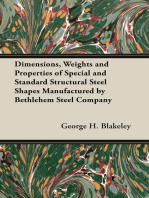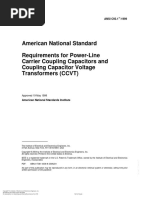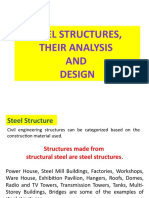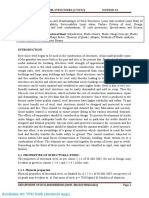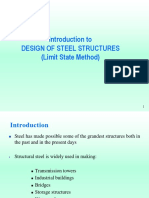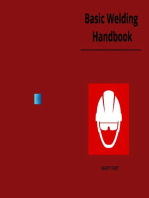CH 1 Introd Steel Struc.
CH 1 Introd Steel Struc.
Uploaded by
Haftom GebreegziabiherCopyright:
Available Formats
CH 1 Introd Steel Struc.
CH 1 Introd Steel Struc.
Uploaded by
Haftom GebreegziabiherOriginal Title
Copyright
Available Formats
Share this document
Did you find this document useful?
Is this content inappropriate?
Copyright:
Available Formats
CH 1 Introd Steel Struc.
CH 1 Introd Steel Struc.
Uploaded by
Haftom GebreegziabiherCopyright:
Available Formats
1.
Introduction to Structural Steel
Steel as Structural Materials of Construction
Steel is one of the most important structural materials of construction. It can be used for
construction of roof trusses of residence and industrial buildings of large span, frame work of
high rise and industrial buildings, long span bridges, storage tanks, transmission towers, any
structures built over poor foundation condition, and etc. A significant difference between steel
and concrete structures is that the designer has more control over the shape of reinforced concrete
elements. For steel structure, the designer is normally compelled to use standard rolled sections.
Advantages of Steel as Structural Materials
1. It is homogeneous, isotropic and elastic materials. These make structural steel design closer to
the assumption.
2. Steel members have high tensile and compressive strength compared to its unit weight.
Therefore, a steel member of a smaller section which has little self weight is able to support
heavy imposed loads.
3. Steel members are light in weight, and they can be conveniently handled and transported.
4. Steel, being a ductile material, does not fail suddenly, but gives visible evidence of impending
failure by large deflections.
5. Speed of erection of members of frame work of structures.
6. Additions and alterations can be made easily to steel structures.
7. Possible re-use after a structure is disassembled (steel has highest scrap value).
Disadvantages of Steel as Structural Materials
1.Steel rust or corrodes in normal exposure condition. Therefore, it needs frequent periodic
painting may be every two years. Alloying steel with copper may improve the situation, but
alloyed-steel is expensive.
2. Steel is not fire resistance material. Structural steel member is better to be imbedded in
concrete or other insulating materials to protect from fire.
Mechanical Properties of Structural Steel
The mechanical properties of structural steel are best be represented by stress-strain curve. Stress-
strain curve of steel are obtained by tension test of steel specimen, by continuously recording the
applied incremental tension load and the corresponding dial measuring of extension of gage
length of specimen. A typical stress-stain curve for structural steel is shown below.
Fu
Aproportional limit
D Byield point (for no obvious yield
F point, it is defined by 0.2% offset)
Fy
A Dultimate strength point
B C Ffracture point
stress ,
MPa OAelastic range
BCplastic range (continuous deformation
without any increase of loads)
CDstrain (work) hardening range (where
ES = 200GPa molecular arrangement takes place)
O
strain, (mm/mm)
In all structural steel design, either yield-strength or ultimate tensile strength of steel is
considered. Steel producers provide different grades for their products. These grades are based on
yield-strength of steel defined by point B of stress-strain diagram. The yield-strength specified
by steel produces is the guaranteed minimum value, and it is based on statistics of large number
1 Chapt.-1: Introduction to Steel Structures by Haftom G.
of tests. For example for A-36 steel, the guaranteed yield-strength is 250 MPa , but the most
likely value is on the order of 300 to 330 MPa .
The most commonly used grades of structural steel according to ASTM are:
A-36 steel (the most economical in terms of cost/unit mass) F y 250 MPa and
Fu 400 MPa and, A-50 steel (ASTM A-441 and A-588)
Fy 345 MPa and Fu 485 MPa
Other higher strength of structural steels are available with ASTM A-572 specification covering
several grades as A-42, A-45, A-55, A-60, and A-65 corresponding to guaranteed minimum yield
strengths of 290, 310, 380, 415, and 450 MPa , respectively. But, yield strength of these steels is
thickness dependent.
t 40 mm 40 mm t 100 mm
Fe-360 Fy = 235 MPa Fu = 360 MPa Fy = 215 MPa Fu = 340 MPa
Fe-430 Fy = 275 MPa Fu = 430 MPa Fy = 255 MPa Fu = 410 MPa
Fe-510 Fy = 355 MPa Fu = 510 MPa Fy = 335 MPa Fu = 490 MPa
Structural steel grades according to EBCS-3/95 are given in the table below.
Other important properties of steel that may be incorporated in design of steel structures
are as follows:
1. Modulus of Elasticity, Es: the typical range for all steel grades is 193 to 207 GPa . The value
for design is commonly taken as 200 GPa .
2. Shear Modulus, G: the shear modulus of any elastic material is computed as
E
G
2 1
where --poissons ratio taken as 0.3 for steel
Using = 0.3 gives G = 77 GPa .
3. Coefficient of Expansion, : may be taken as
11 .25 x 10 6 / 0 c
4. Mass density or weight density of steel:
Mass density = 7850 kg/m3
Weight density = 76.975 kN/m3
5. High Temperature Effects on Steel: Special consideration is not required for steel under
normal temperature. When the temperature is exceeding 200 0c, modulus of elasticity, yield-
strength and ultimate tensile strength of steel are deceasing. For example yield-strength of steel
at 500 0c is about 60 to 70 % of yield strength at normal temperature. The drop in strength is
rather marked at higher temperatures where the strength at 850 0c is about 15 %. Steel frames
need to be enclosed by insulating material to give fire protection to control the temperature of
the metal for a sufficient time for the occupants to seek safety. These fire insulators may
include gypsum-based products or light weight concrete that can be sprayed onto the member or
fiber insulation boards that are placed and banded to protect the steel.
6.Fatigue-Limit: Fatigue failure occurs when the structure is repeatedly loaded and unloaded
even if the stress developed at point in structure due to repeated loading is never exceeding the
yield point of steel. Large number repeated stress applications tend to cause a fracture of the
2 Chapt.-1: Introduction to Steel Structures by Haftom G.
material at the location where small imperfection (may be microscopic) exists. A crack forms,
and depending on stress level, slowly progresses to failure of the part of member. Fatigue
problem exist only when tension involves. Fatigue strength of steel is the stress-level at which
member of material of steel is fractured up on application of given number of cycles of loading
of the same stress-level. The fatigue strength of steel is decreasing with the increase of the
loading cycles. The stress level that steel fails at constant value of stress after large number of
cycles of loading (at about 2 millions cycles) is known as fatigue-limit. Therefore, for design of
structure (like steel-bridge) subjected to more than 2 millions of cycles of loading in its life
time, fatigue-limit of steel has to be considered in addition to yield-strength and ultimate tensile
strength of steel. Since building structure is assumed on average subjected to less than 100,000
cycles of loading in its life time, fatigue is not important in design. A typical plot of fatigue-
strength viz. number of loading cycles of steel is shown below.
Fy
fatigue
strength,
MPa fatigue-Limit
100,000 2 millions N (no. of loading)
cycles
Rolled Structural Steel Sections
The followings are the most common types of steel rolled sections produced by steel mills and
they are available with different sizes. The design of steel sections is governed by cross-sectional
area and section-modulus. Therefore, tables of standard rolled sections must contain section
properties including cross-sectional area and section modulus that may be useful in selection of
the required section of members of structure.
Solid round Solid square Solid rectangular Plate Angle section
bar bar bar PL b x t (equal or unequal leg)
L b1 x b2 x t
Channel section Wide-flanged section Small-flanged section Tee section Square tube
C d x wt. W d x wt. (American standard beam) WT d x wt. ST d x t
S d x wt.
Plate-girders made up
of connection of
flanges and web plates
single wire or cables Built-up sections
Rectangular tube Circular tube composed of several made-up of connection
RT d x b x t CT d x t small wires of basic rolled sections
3 Chapt.-1: Introduction to Steel Structures by Haftom G.
4 Chapt.-1: Introduction to Steel Structures by Haftom G.
You might also like
- UBC ASHRAE Competition Report PDFDocument34 pagesUBC ASHRAE Competition Report PDFmech118100% (1)
- Design of Steel StructuresDocument2,529 pagesDesign of Steel StructuresStructural Spreadsheets70% (10)
- Design of Steel and Timber Structures - ExamplesDocument78 pagesDesign of Steel and Timber Structures - Examplesሃይለ ገብረስላሴ92% (73)
- SpiralWeld - DesignDocument26 pagesSpiralWeld - DesignSH1961100% (1)
- Dimensions, Weights and Properties of Special and Standard Structural Steel Shapes Manufactured by Bethlehem Steel CompanyFrom EverandDimensions, Weights and Properties of Special and Standard Structural Steel Shapes Manufactured by Bethlehem Steel CompanyNo ratings yet
- Reinforced Concrete Buildings: Behavior and DesignFrom EverandReinforced Concrete Buildings: Behavior and DesignRating: 5 out of 5 stars5/5 (1)
- ANSI C93.1-1999 Coupling Capacitor VoltageDocument47 pagesANSI C93.1-1999 Coupling Capacitor VoltageTerefe Tadesse100% (1)
- Chapter 1 Introd-Steel Struc.Document4 pagesChapter 1 Introd-Steel Struc.Eng Abdikarim WalhadNo ratings yet
- Introd-Steel Struc.Document4 pagesIntrod-Steel Struc.Fuad AhmedinNo ratings yet
- Chapter 1Document6 pagesChapter 1Haftom GebreegziabiherNo ratings yet
- Bolted and Riveted ConnectionsDocument42 pagesBolted and Riveted Connectionsbayang000No ratings yet
- building technologyDocument59 pagesbuilding technologytrexwow62No ratings yet
- Nonlinear Material Properties of StructuralDocument9 pagesNonlinear Material Properties of Structuralkhawaja AliNo ratings yet
- Module1 IntroductionDocument13 pagesModule1 Introductionmarlo ignacioNo ratings yet
- Type of Structural SteelDocument18 pagesType of Structural SteelaltavanoarNo ratings yet
- Chapter 1 IntroductionDocument8 pagesChapter 1 Introductiondawitdaawit626No ratings yet
- Design of Steel and Timber Structures Examples PDFDocument78 pagesDesign of Steel and Timber Structures Examples PDFsamson100% (3)
- Steel Structure, Their Analysis and DesignDocument27 pagesSteel Structure, Their Analysis and Designnabinniraula100% (2)
- Plastic Design: Steel StructuresDocument56 pagesPlastic Design: Steel StructuresSSNo ratings yet
- IM BSCE 4 - Steel Design Part 1Document86 pagesIM BSCE 4 - Steel Design Part 1acurvz2005No ratings yet
- Adobe Scan 08-Jan-2025Document3 pagesAdobe Scan 08-Jan-2025124101053No ratings yet
- Structural Design of Steel StructuresDocument43 pagesStructural Design of Steel Structureskiran sreekumarNo ratings yet
- c2Document39 pagesc2Patrik GăiceanNo ratings yet
- CE-6117-Lecture-1,2-Course Plan-Advanced Design of Steel StructuresDocument117 pagesCE-6117-Lecture-1,2-Course Plan-Advanced Design of Steel StructuresTanjilul HaqueNo ratings yet
- Design Provisions of BS 5950 Part 1Document21 pagesDesign Provisions of BS 5950 Part 1ISMAEL SHAIK86% (7)
- Study of Manufacturing Processes and Stress Analysis of I Beams Using AnsysDocument6 pagesStudy of Manufacturing Processes and Stress Analysis of I Beams Using AnsysVijay AravindNo ratings yet
- AR136 LEC1 IntroductionDocument39 pagesAR136 LEC1 IntroductionAngela MaeNo ratings yet
- Steel Structure ALL in ONE LECTURE NotesDocument64 pagesSteel Structure ALL in ONE LECTURE Notesobsadaniel63No ratings yet
- Beton IIIDocument25 pagesBeton IIIChrist Allienz D'skeithNo ratings yet
- Steel Timber Design Design of Simply Supported Steel Section BeamDocument54 pagesSteel Timber Design Design of Simply Supported Steel Section BeamTj InumerableNo ratings yet
- Section Two: Steel Pipe DesignDocument21 pagesSection Two: Steel Pipe DesignItay Bar-LevNo ratings yet
- 10 - Chapter10Document4 pages10 - Chapter10HundeejireenyaNo ratings yet
- References: CEEN 043 Behavior & Properties of Engineering MaterialsDocument7 pagesReferences: CEEN 043 Behavior & Properties of Engineering MaterialskishoryawaleNo ratings yet
- ASTLTIMD. Module 5a. Design of Steel BeamsDocument7 pagesASTLTIMD. Module 5a. Design of Steel BeamsvaneNo ratings yet
- Steel DesignDocument140 pagesSteel DesignGlenn PaaNo ratings yet
- Design of Steel and Timber Structures.Document101 pagesDesign of Steel and Timber Structures.yenebeb tariku89% (18)
- ASWP Manual - Section 2 - Steel Pipe Design (6-2013)Document21 pagesASWP Manual - Section 2 - Steel Pipe Design (6-2013)Shahril Izzuddin Or DinoNo ratings yet
- Lesson-1-3 (CE 321C)Document81 pagesLesson-1-3 (CE 321C)Andjie LeeNo ratings yet
- Drawings Structural SteelDocument57 pagesDrawings Structural SteelSantu MganoNo ratings yet
- Steel Design EC3Document45 pagesSteel Design EC3Tiago CunhaNo ratings yet
- Report Final Aa6+24 Special Rev. 03Document77 pagesReport Final Aa6+24 Special Rev. 03Ika RosikaNo ratings yet
- Chapter 1-IntroductionDocument22 pagesChapter 1-IntroductionmelkamuekoNo ratings yet
- Module - 1 Introduction: Advantages and Disadvantages of Steel Structures, Limit State Method Limit State ofDocument12 pagesModule - 1 Introduction: Advantages and Disadvantages of Steel Structures, Limit State Method Limit State of2BA19CV059 Rakshita SarangmathNo ratings yet
- Stress-Strain Relationship of High-Strength Steel (HSS) Reinforcing BarsDocument9 pagesStress-Strain Relationship of High-Strength Steel (HSS) Reinforcing BarsAISWARYA K VIJAY M.Tech CASE 2021-2023No ratings yet
- Singly Doubly RNF BeamDocument45 pagesSingly Doubly RNF BeamAditya SutarNo ratings yet
- 4Document7 pages4Malith De SilvaNo ratings yet
- Transmission Mono Poles-SERCDocument49 pagesTransmission Mono Poles-SERCtmmsekar100% (2)
- 01 - Introduction - 1Document42 pages01 - Introduction - 1TanvirH.ChowdhuryNo ratings yet
- Chap 1 &2Document27 pagesChap 1 &2kbromNo ratings yet
- design of steel and RCCDocument13 pagesdesign of steel and RCCravitripathi1221No ratings yet
- Ce 3003 Steel Kac Lecture Notes - 2020-2021 - AnnotatedDocument109 pagesCe 3003 Steel Kac Lecture Notes - 2020-2021 - AnnotatedMannyNo ratings yet
- Lec1 PDFDocument6 pagesLec1 PDFJuan KikoNo ratings yet
- Steel Interchange: Stability of Beams During Erection Fire Rating of Concrete-Filled HSS MembersDocument2 pagesSteel Interchange: Stability of Beams During Erection Fire Rating of Concrete-Filled HSS Membershector diazNo ratings yet
- Steel and Timber Ch-1 PPTDocument21 pagesSteel and Timber Ch-1 PPTdaniNo ratings yet
- What Are The Mechanical Properties of Structural Steel?: Resistence To Deformation Based UponDocument5 pagesWhat Are The Mechanical Properties of Structural Steel?: Resistence To Deformation Based UponEni VinoNo ratings yet
- Design of Steel Structures 2Document3,379 pagesDesign of Steel Structures 2Structural SpreadsheetsNo ratings yet
- Ilovepdf Merged PDFDocument784 pagesIlovepdf Merged PDFRe DesignNo ratings yet
- Introduction To Steel StructureDocument51 pagesIntroduction To Steel Structureshemal100% (1)
- Composite Structures of Steel and Concrete: Beams, Slabs, Columns and Frames for BuildingsFrom EverandComposite Structures of Steel and Concrete: Beams, Slabs, Columns and Frames for BuildingsNo ratings yet
- Structural Steel Design to Eurocode 3 and AISC SpecificationsFrom EverandStructural Steel Design to Eurocode 3 and AISC SpecificationsNo ratings yet
- Analysis and Design of Cantilever Solid Slab (First Floor Slab)Document23 pagesAnalysis and Design of Cantilever Solid Slab (First Floor Slab)Haftom GebreegziabiherNo ratings yet
- ConjunctionsDocument7 pagesConjunctionsHaftom GebreegziabiherNo ratings yet
- Department of Civil and Combat Engineering D.E.C DebrezietDocument18 pagesDepartment of Civil and Combat Engineering D.E.C DebrezietHaftom GebreegziabiherNo ratings yet
- Reinforced Concrete I: Lecture-2Document25 pagesReinforced Concrete I: Lecture-2Haftom GebreegziabiherNo ratings yet
- Structural Design For Laura Real Estate: Final MomentDocument6 pagesStructural Design For Laura Real Estate: Final MomentHaftom GebreegziabiherNo ratings yet
- Problems (Beams)Document15 pagesProblems (Beams)Haftom Gebreegziabiher100% (3)
- Design of Typical BeamDocument10 pagesDesign of Typical BeamHaftom GebreegziabiherNo ratings yet
- Problems (Axial-Force 2)Document8 pagesProblems (Axial-Force 2)Haftom Gebreegziabiher100% (1)
- Worksheet 1 Tension Members: S S? S SDocument2 pagesWorksheet 1 Tension Members: S S? S SHaftom Gebreegziabiher100% (1)
- Prob.-1 (Axial-Force+bend.)Document1 pageProb.-1 (Axial-Force+bend.)Haftom GebreegziabiherNo ratings yet
- N A F KN Given T P: Example Problems On Bolted-ConnectionsDocument13 pagesN A F KN Given T P: Example Problems On Bolted-ConnectionsHaftom Gebreegziabiher100% (1)
- Example Problems On Timber-Structures: MM N FDocument8 pagesExample Problems On Timber-Structures: MM N FHaftom GebreegziabiherNo ratings yet
- Example StrengthDocument3 pagesExample StrengthHaftom GebreegziabiherNo ratings yet
- Chapter Two Torsion: Figure-2-1Document5 pagesChapter Two Torsion: Figure-2-1Haftom GebreegziabiherNo ratings yet
- Chapter One: Mechanics of Materials Is A Branch of Applied Mechanics That Deals With The Behavior of SolidDocument4 pagesChapter One: Mechanics of Materials Is A Branch of Applied Mechanics That Deals With The Behavior of SolidHaftom GebreegziabiherNo ratings yet
- Floor Loads: Project Date Description by CHKDDocument13 pagesFloor Loads: Project Date Description by CHKDHaftom GebreegziabiherNo ratings yet
- Deflections of BeamsDocument7 pagesDeflections of BeamsHaftom GebreegziabiherNo ratings yet
- Floor LoadDocument13 pagesFloor LoadHaftom GebreegziabiherNo ratings yet
- Equilibrium: M Are Both ZeroDocument8 pagesEquilibrium: M Are Both ZeroHaftom GebreegziabiherNo ratings yet
- Typical Floor BeamDocument13 pagesTypical Floor BeamHaftom GebreegziabiherNo ratings yet
- Floor Loads: Project Date Apr-04 Description Seismic Analysis of Structure by Thomas S. CHKDDocument10 pagesFloor Loads: Project Date Apr-04 Description Seismic Analysis of Structure by Thomas S. CHKDHaftom GebreegziabiherNo ratings yet
- Design of RC Box-Culverts: A) Case 1 B) Case 2 C) Case 3Document6 pagesDesign of RC Box-Culverts: A) Case 1 B) Case 2 C) Case 3Haftom GebreegziabiherNo ratings yet
- Strategic DriftDocument3 pagesStrategic DriftBecks Ali50% (2)
- Doble Test ProceduresDocument21 pagesDoble Test ProceduresRamKumarNo ratings yet
- Rejection ListDocument356 pagesRejection ListTrilikita ReddyNo ratings yet
- Ceramic Brakes in Audi VehiclesDocument24 pagesCeramic Brakes in Audi VehiclesKhaled Barghouthi67% (3)
- Indian Oil Corporation Limited (Refineries Division) (Mathura Refinery)Document10 pagesIndian Oil Corporation Limited (Refineries Division) (Mathura Refinery)mohit pandeyNo ratings yet
- The Bcs Professional Examinations BCS Level 4 Certificate in ITDocument4 pagesThe Bcs Professional Examinations BCS Level 4 Certificate in ITAbiodun AdebayoNo ratings yet
- Ismail 2016 IOP Conf. Ser. Mater. Sci. Eng. 114 012108Document10 pagesIsmail 2016 IOP Conf. Ser. Mater. Sci. Eng. 114 012108Bilal KhaliqNo ratings yet
- Read This First: Setting DefaultDocument42 pagesRead This First: Setting DefaultmathoneNo ratings yet
- CS615 Grand Quiz 1 (Solved)Document27 pagesCS615 Grand Quiz 1 (Solved)Asim Ihsan (Apna)No ratings yet
- Transforming Education in Indonesian Higher EducatDocument7 pagesTransforming Education in Indonesian Higher EducatTata Ruang SumbarNo ratings yet
- Pi Musicbox Documentation: Release 0.7.0Rc5Document33 pagesPi Musicbox Documentation: Release 0.7.0Rc5Pepe LepewNo ratings yet
- Optimization of Machining Parameter For Turning of en 16 SteelDocument5 pagesOptimization of Machining Parameter For Turning of en 16 SteelShivam SharmaNo ratings yet
- Digital Personal AssistantsDocument9 pagesDigital Personal AssistantsTechzone YTNo ratings yet
- 1969 Index PDFDocument2 pages1969 Index PDFTareq Al ShyoukhyNo ratings yet
- Tech Article - Optimized Use of Power Supply ModuleDocument3 pagesTech Article - Optimized Use of Power Supply ModuleSandeep NairNo ratings yet
- Manual CS 300Document20 pagesManual CS 300oprea vasileNo ratings yet
- SL1968 004 PDFDocument14 pagesSL1968 004 PDFBas Van TilburgNo ratings yet
- 1cd r1 MotoadminDocument55 pages1cd r1 MotoadminMatheus OliveiraNo ratings yet
- Honda Civic 92-95 Workshop Manual 62sr300bDocument893 pagesHonda Civic 92-95 Workshop Manual 62sr300biraklitosp83% (6)
- Tube Installation Accessories: GT Serrating ToolsDocument8 pagesTube Installation Accessories: GT Serrating ToolsMilad MNo ratings yet
- BC846, BC847, BC848Document8 pagesBC846, BC847, BC848qwerty qwertyNo ratings yet
- Unit 2 - Second LawDocument32 pagesUnit 2 - Second LawDeepank SachdevNo ratings yet
- Dock Trial Test Skema 0788811-7.0Document1 pageDock Trial Test Skema 0788811-7.0Şansal DikmenerNo ratings yet
- Labour Management Using Android ApplicationDocument3 pagesLabour Management Using Android ApplicationIJRASETPublicationsNo ratings yet
- Copy of Devesh 5 AprailDocument93 pagesCopy of Devesh 5 AprailYash BarethNo ratings yet
- Product Data Sheets Plasma 12 Strand 0Document2 pagesProduct Data Sheets Plasma 12 Strand 0CornellixNo ratings yet
- Pathfinder: Product Support ManualDocument19 pagesPathfinder: Product Support Manual王大明No ratings yet
- Corrective Vs Preventive ActionDocument2 pagesCorrective Vs Preventive ActionTommyCasillas-GerenaNo ratings yet




